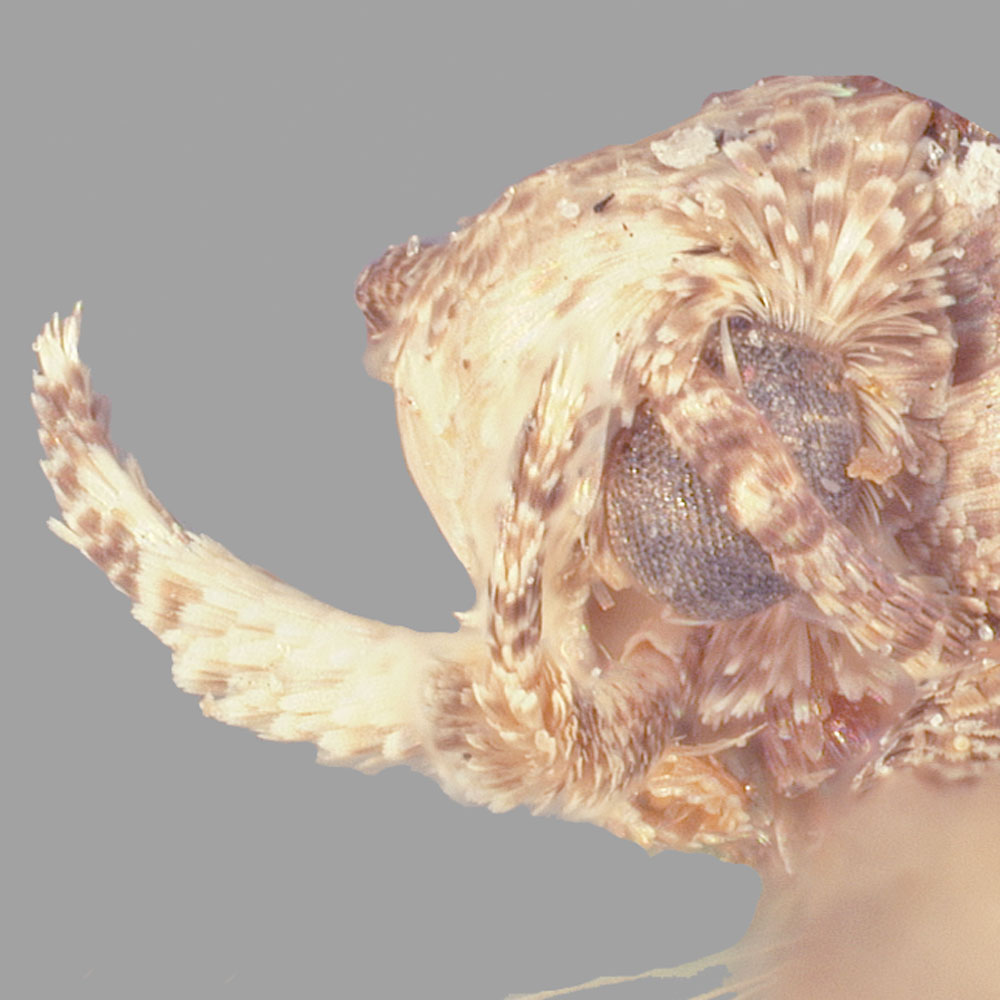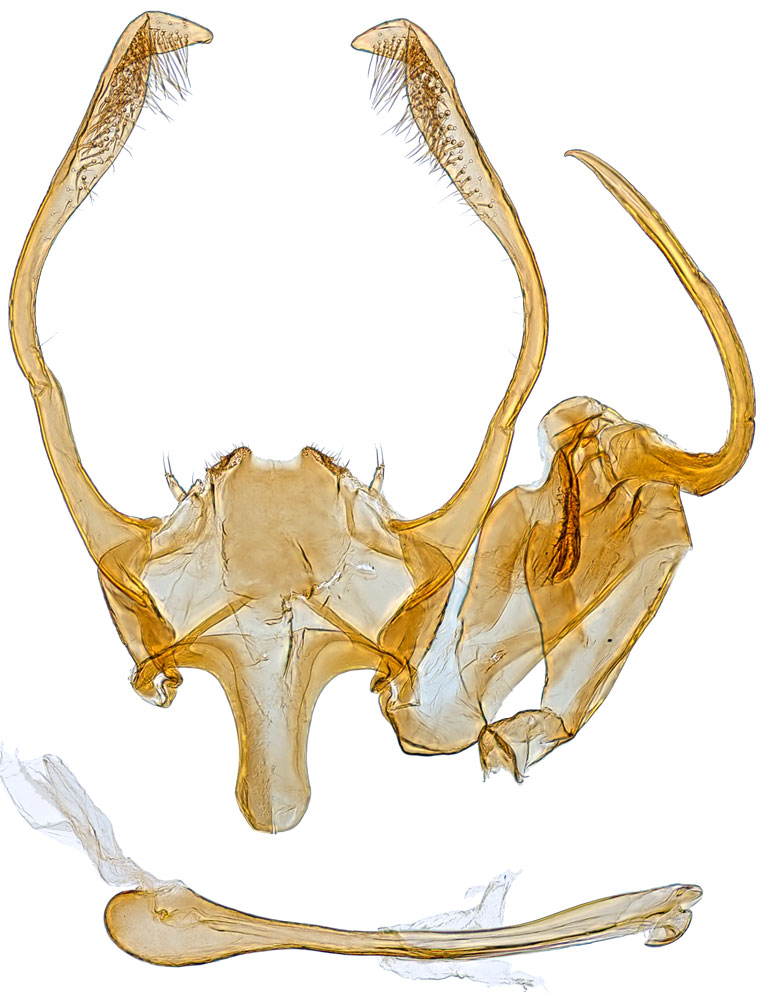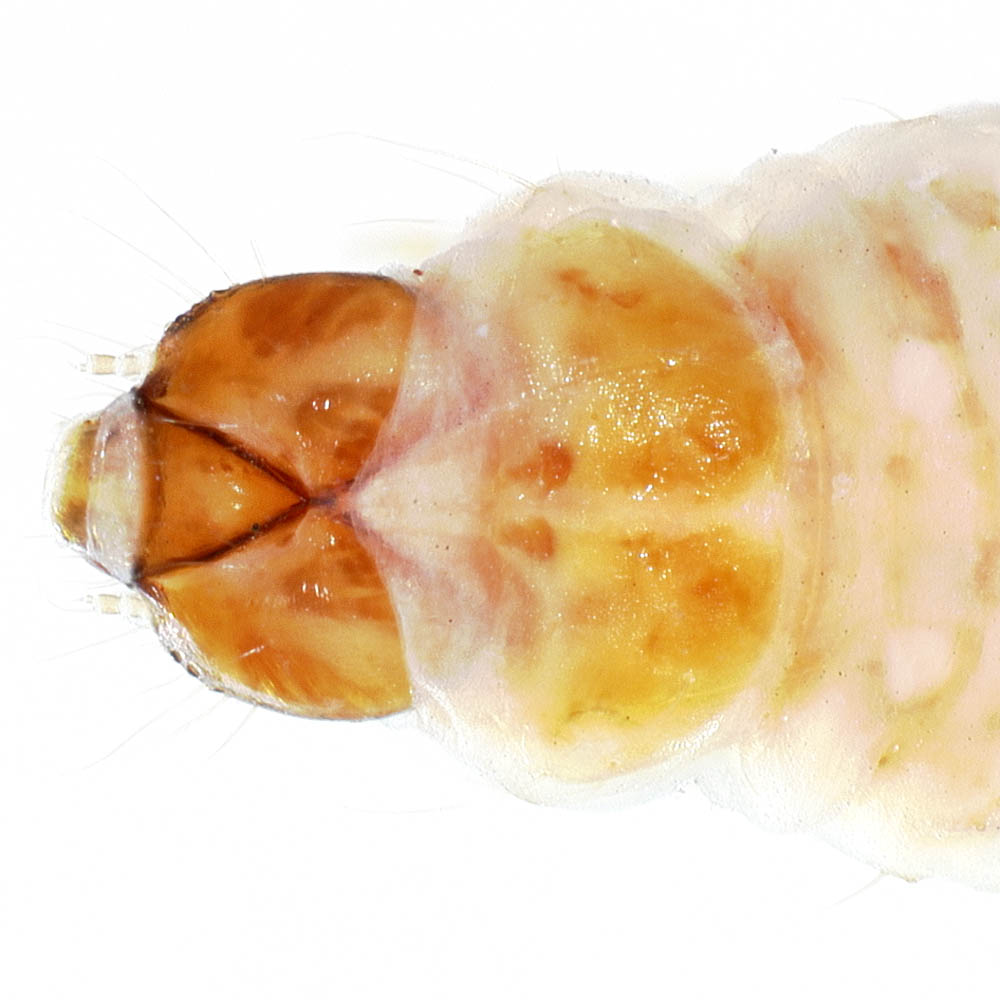Keiferia inconspicuella
|
Keiferia inconspicuella habitus. Scale = 5 mm. |
|
Keiferia inconspicuella head. |
|
Keiferia inconspicuella male genitalia. |
|
Keiferia inconspicuella female genitalia. |
|
Larva of Keiferia inconspicuella, raised from eggplant, associated with dissected adults. |
|
Head and prothoracic shield of Keiferia inconspicuella. |
Name
Keiferia inconspicuella (Murtfeldt, 1883)
Common name: eggplant leafminer
Original combination: Gelechia inconspicuella Murtfeldt, 1883
Synonyms: Gelechia cinerella Murtfeldt, 1881
Alternative combinations: Keiferia cinerella (Murtfeldt, 1881)
Classification: Gelechioidea: Gelechiidae: Gelechiinae: Gnorimoschemini
Adult recognition
Adults are about 5.0–5.5 mm in forewing length. They are gray mottled with dark gray and yellowish orange. The labial palpusLabial palpus:
The more prominent, elongate pair of appendages on the head, usually three-segmented (pl. palpi).
-800px.jpg) is upturned. The hindwing is light to medium gray and trapezoidal with a long fringe of hairs. The male genitalia have a sickle-shaped uncusUncus:
is upturned. The hindwing is light to medium gray and trapezoidal with a long fringe of hairs. The male genitalia have a sickle-shaped uncusUncus:
The prominent projection from the dorsal tegumen of the male genitalia. May be variously shaped as a hook, knob, hood, etc.
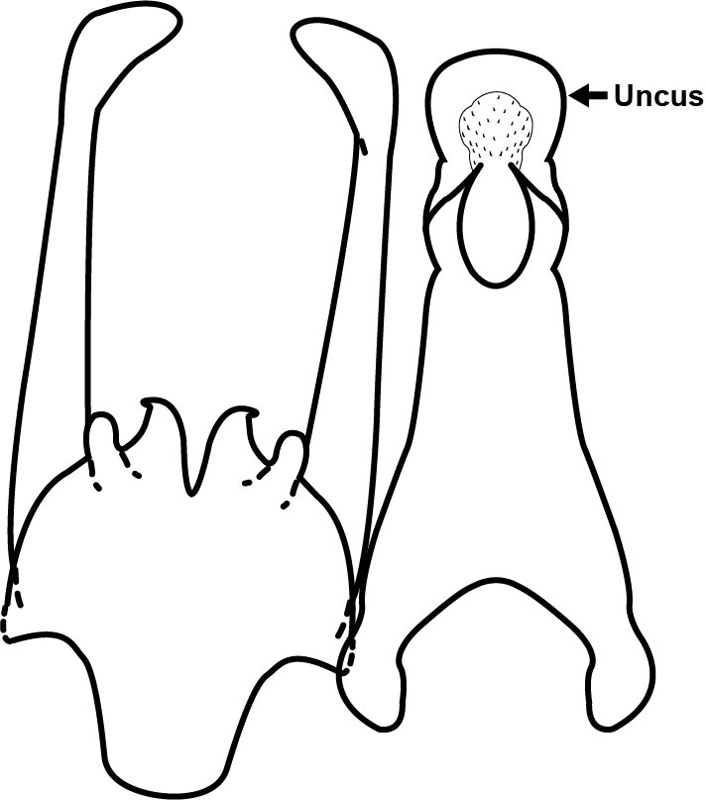 with strongly curved base, elongate valvaValva:
with strongly curved base, elongate valvaValva:
One of the pair of large lateral appendages of the male genitalia (pl. valvae).
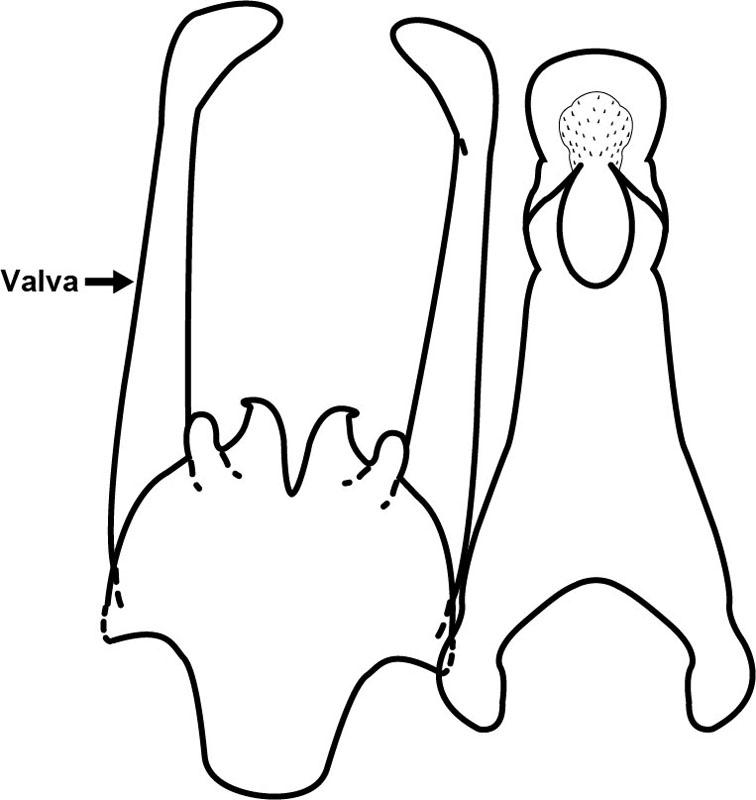 with triangular apex, and posterior margin of the vinculumVinculum:
with triangular apex, and posterior margin of the vinculumVinculum:
The ventral half of the male genitalia, from which the valvae arise.
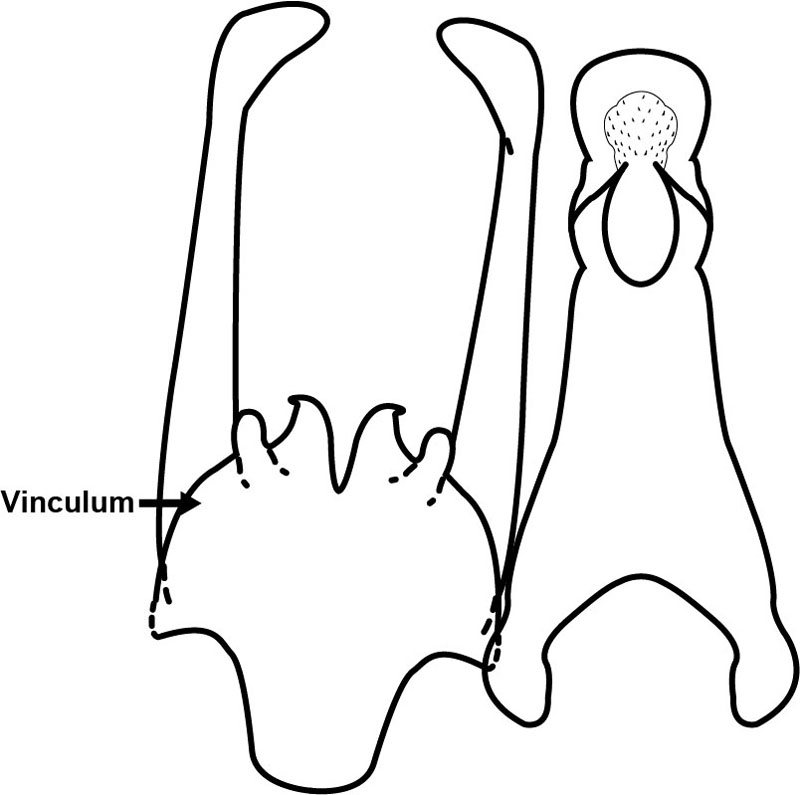 shallowly excavated medially with paired vestigial hump-like processes. Females have a funnel-shaped antrumAntrum:
shallowly excavated medially with paired vestigial hump-like processes. Females have a funnel-shaped antrumAntrum:
Posterior section of the ductus bursae, posterior of the colliculum.
 and a large sickle-shaped signumSignum:
and a large sickle-shaped signumSignum:
Any sclerite, sclerotized area, or discrete granular area on the wall of the corpus bursae (pl. signa).
 .
.
Immature stages
Larvae when fully grown are about 7–8 mm long, cylindrical, slightly flattened in form, and green colored. The head and T1 shield are light brown without a posterior band. The fifth tooth of the mandibleMandible:
The chewing mouthparts of the larva, typically with teeth and two setae.
 , being small and pointed, is easily worn smooth and missed.
, being small and pointed, is easily worn smooth and missed.
PDF - Dichotomous key to Gelechiid larvae
Similar species
This species is allied to Keiferia altisolani in wing size and color, but it differs in that the male valvaValva:
One of the pair of large lateral appendages of the male genitalia (pl. valvae).
 is elongate with a triangular apex, and the vinculumVinculum:
is elongate with a triangular apex, and the vinculumVinculum:
The ventral half of the male genitalia, from which the valvae arise.
 processes are vestigial and hump-like, whereas the valvaValva:
processes are vestigial and hump-like, whereas the valvaValva:
One of the pair of large lateral appendages of the male genitalia (pl. valvae).
 is bifurcate in K. altisolani.
is bifurcate in K. altisolani.
Keiferia inconspicuella can be separated from other species in our study by the lack of a dark band on the posterior margin of the prothoracic shieldProthoracic shield:
Also called the T1 shield. In the larva, the extensive sclerotized area of the dorsal half of the prothorax. It bears six setae on each side, and its color pattern is often diagnostic.
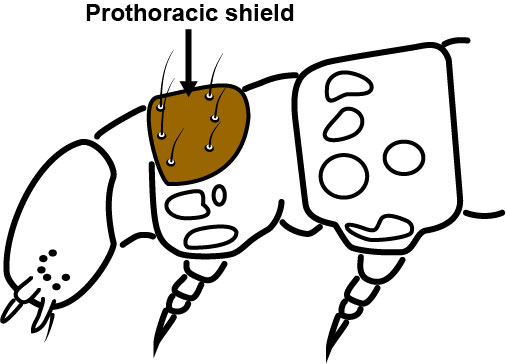 , the trisetose L group on A9, the rounded head, pale thoracic legs, the eastern United States distribution and the host being either Solanum melongena or S. carolinense but not Solanum xanti. They tend to mine the edge of the leaves unlike P. operculella that occupies the central portions of the leaf.
, the trisetose L group on A9, the rounded head, pale thoracic legs, the eastern United States distribution and the host being either Solanum melongena or S. carolinense but not Solanum xanti. They tend to mine the edge of the leaves unlike P. operculella that occupies the central portions of the leaf.
Larvae on S. carolinense in parts of Texas can be either K. glochinella or K. inconspicuella. These will have to be reared to the adult stage until the larva of K. glochinella is described with certainty.
Behavior
Larvae burrow within the leaf along the edge of the leaf blade. They make a blotch-shaped mine and deposit feces and silk within the mine, causing leaves to turn brown.
Distribution
Native to North America. USA (southeastern and midwestern United States north to about New Jersey and Iowa and west to Nebraska and Texas).
Hosts
Solanum melongena L. (Eggplant)
Solanum carolinense L. (Carolina horsenettle)
Comments
This species was described with the larva observed to cause the leaves of the host plants to turn brown.
Literature
Busck 1939Busck 1939:
Busck A. 1939. Restriction of the genus Gelechia (Lepidoptera: Gelechiidae), with descriptions of new genera. Proceedings of the United States National Museum 86: 563-593, pl. 58-71.
Hodges 1969Hodges 1969:
Hodges RW. 1969. Synonymy of Keiferia glochinella (Zeller) and related names (Lepidoptera: Gelechiidae). Proceedings of the Entomological Society of Washington 71: 34-37.
Murtfeldt 1881Murtfeldt 1881:
Murtfeldt ME. 1881. New species of Tineidae. Canadian Entomologist 13: 242-246.
Murtfeldt 1883Murtfeldt 1883:
Murtfeldt ME. 1883. Zeller#39;s collections, errata, etc. Canadian Entomologist 15: 138-139.


